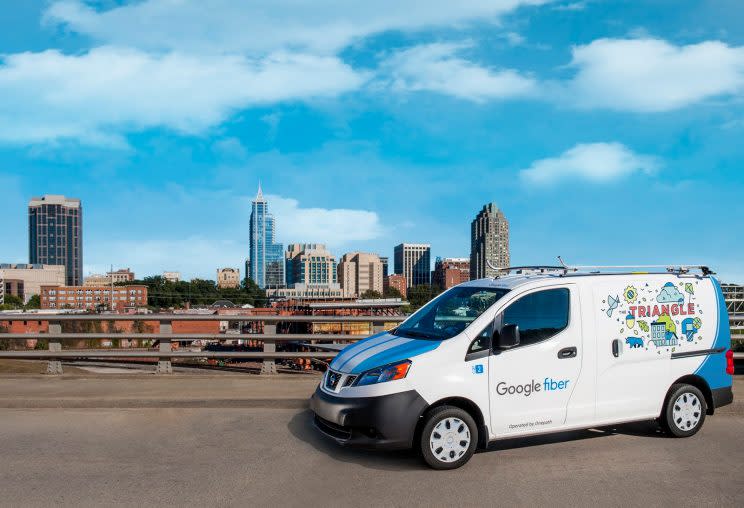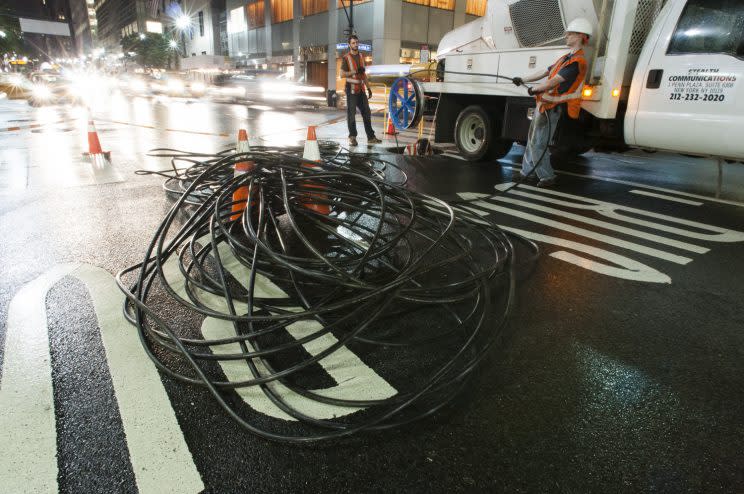Broadband companies can’t build out their networks, and it's hurting consumers

You can’t get Republicans and Democrats to agree about much these days, especially when it comes to telecom policy. But one issue finds them on the same page for once: It’s too hard to build out broadband internet services.
The last three heads of the Federal Communications Commission — Obama’s picks, Julius Genachowski and Tom Wheeler, and President Trump’s chair Ajit Pai — all said as much.
Each advocated reforms to make it easier for new broadband service providers to attach their gear to existing utility poles, and to ensure that road and rail projects add infrastructure for broadband expansion.
And they were right. Deployment holdups have left markets dominated by at most two companies, or just the local cable operator, which ends up hurting consumers.
Strung up on poles
A conference in Washington held last week by the telecom trade association Incompas yielded copious testimony on this point.
John Burchett, head of public policy at Google Fiber, led off a panel discussion by recapping the setbacks that the Alphabet, Inc. (GOOG) subsidiary faced when installing its equipment on existing utility poles in Louisville and Nashville.
Traditional rules call for Google to get approval from every other company set up on poles it needs to use — “no one does it in less than 60 days,” Burchett said — and then wait for each to send its own crew to relocate boxes as necessary.
The result? After 11 months of work, Google Fiber had 33 poles set up for its network — out of some 88,000 the company needed.
That and other obstacles like apartment and condominium building owners restricting access to their structures, a problem tackled by a recent San Francisco ordinance, can push a company to focus on the wealthiest potential customers, which only aggravates digital-divide issues.
Nashville passed a “one touch make ready” rule that lets a newcomer hire a contractor pre-approved by a pole’s owner to do all necessary work. AT&T (T) responded by suing the city, alleging that the new regulation violated FCC rules.

Building on other companies’ infrastructure can also come with outsized costs. Panelist Kurt Van Wagenen, CEO of FirstLight Fiber, called an unnamed electric utility’s quote of $80,000 a mile to build fiber on its right of way “pretty much triple what our average costs are to build fiber anywhere.”
Many cities and towns welcome competitive broadband, but you can’t assume a friendly reception. “Some localities look at you like a way to make money,” warned panelist Mary McDermott, general counsel for Lumos Networks.
Dig once, we must
The members of that panel did, however, all support “dig once” rules mandating that new infrastructure projects add conduits for future broadband.
Van Wagenen and Rocket Fiber co-founder and chief operating officer Edi Demaj said their firms had already benefited from local dig-once ordinances. Demaj’s company, for example, took advantage of fiber right-of-way prepared during a light-rail project in Detroit.
In an interview following the panel, Demja credited the Detroit’s dig-once rule and other moves with easing Rocket’s broadband buildout after a tough start.
“You had to go through like seven different departments to get a permit to cross the street,” he said of Rocket’s early permitting experiences before the city began streamlining things.
For a while, Rocket Fiber even found it advisable to keep its name off its trucks — Demaj said they instead featured a forgettable security-technology moniker — to avoid drawing the attention of incumbent providers or getting potential customers’ hopes up too early.
Demaj said outside Detroit the hassle factor — best understood as the risk of running out of money before you can sign up customers — is still a problem.
“We’re still dealing with the same issues we’ve been dealing with over a decade,” he said.
You’ve seen this movie before
The FCC recognized these headaches almost seven years ago in then-Chairman Genachowski’s National Broadband Plan, which endorsed make-ready rules and dig-once legislation.
Wheeler, too, backed those reforms, writing in a 2016 blog post that dig-once policies ”will speed up the deployment of broadband infrastructure to unserved communities.”
Pai, in turn, recommended pole-attachment reform and dig-once policies in a “Digital Empowerment Agenda” released last year.
So what’s the holdup?

“Dig once, announce 20 times,” joked Blair Levin, who ran the FCC’s broadband initiative from 2009 to 2010. He said that at that time, people weren’t sufficiently aware of these issues — and once Google Fiber’s holdups became a news item, Tom Wheeler found himself preoccupied with topics like net-neutrality.
Incumbent telecom providers, meanwhile, don’t feel the same urgency to grease the skids for competition. Public Knowledge senior vice president Harold Feld observed in an e-mail: “As with many policies that make sense, there are a lot of people who don’t actually like it.”
A 2015 dig-once bill proposed by Reps. Anna Eshoo (D.-Calif.) and Greg Walden (R.-Ore.) never advanced through the House. A newer, mobile-focused bill from Sen. John Thune (R.-S.D.) encourages but not does not require dig-once provisions.
Feld’s colleague John Bergmayer separately pointed out that because states and localities make many of these decisions, Washington’s influence is limited. For instance, dig-once rules on federally-funded roads — mainly highways — “don’t do anything for last-mile competition.”
Hal Singer, a principal at Economists, Inc. and a senior fellow at George Washington University’s Institute for Public Policy, echoed those concerns. He added that while tax credits might coax existing providers to build out fiber, some — he named Verizon (VZ) in particular — are instead content to wait for 5G wireless.
Meanwhile, incumbent providers’ motivations to defend the status quo haven’t changed. As Google’s Burchett said in last week’s panel: “Every month they delay, that’s one more month when they have 90% of the market instead of 50% of the market.”
(Disclosures: I moderated a panel at Incompas’ 2015 conference in San Francisco, in return for which the group covered most of my travel costs. Verizon is buying Yahoo Finance’s parent firm Yahoo.)
More from Rob:
Wireless carriers are fighting for your cash, and that’s good news
How Verizon’s new ‘unlimited’ plan compares to the competition
Study finds most people are scarred of being hacked, but don’t do much about it
Email Rob at [email protected]; follow him on Twitter at @robpegoraro.
